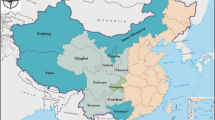Abstract
The USA and China have the world’s largest GDP and greenhouse gas emissions, as well as having a significant proportion of the world’s total population. These form part of the triumvirate of influencing factors which potentially detrimentally impact upon sustainability. How the triumvirate factors have impacted upon the sustainability of the USA and China has not been adequately determined quantitatively or holistically. Understanding this can strongly indicate how significant levels of population, economic growth, and greenhouse gas emissions impacts and influences the indicated levels, nature, and dynamics of sustainability occurring. Therefore, to contribute towards developing understanding of the issues outlined, the Sustainability Dynamics Framework is applied to conduct a sustainability dynamic assessment for the USA and China 1995–2018. The results indicate both countries are consistently unsustainable due to significant levels of triumvirate-based factors, with differing dynamic trends, characteristics, and potential outcomes. The current static nature of the USA’s environment-human system provides the opportunity for a managed co-evolutionary strategy. China’s dynamic trends indicate a significant increasingly stressed environment-human system, which is at risk of a potential systemic crisis or collapse unless stringent corrective measures are implemented. In order for both countries to return to sustainability, there needs to be population mitigation to return them to optimum levels, and the use of contractionary policies and rapid decarbonation of their economies and societies. Unless this occurs, then their continued reticence to undertaking the urgent and necessary measures required not only risking their own future, but the world as well.





Similar content being viewed by others
Data availability
The ND-GAIN and World Bank datasets used to apply the SDF in the paper are available at https://gain.nd.edu/ and https://databank.worldbank.org/ respectively. The Excel datasets used to determine the SDF values and results are available upon request from the author.
Notes
Gaffney and Steffen (2017, p. 55) states that at the highest level of abstraction, the current rate of change in the Earth System (dE/dt) is as follows and can referred to as ‘The Anthropocene Equation: \(\frac{dE}{dt}=\underset{A,G,I\to 0}{f(H)}\) (9). ‘H’ as a sub-system of the Earth System (E), and primary driving force of the rate of change, can be represented as: \(H=f\left(P,C,T\right)\) (10) and \(T=f(En,K,Pe)\) (11).
Glossary: E Earth System, A astronomical forcing, G geophysical forcing, I internal dynamics of the earth system, H human activity, P population, C consumption (by definition production), T Technosphere, En energy system, K knowledge, Pe political economy.
Note: Population (P) defined as the global ‘'consumers’–the upper and middle classes as defined by income on a national basis (Gaffney & Steffen, 2017, p. 57).
References
Chen, C., Noble, I., Hellmann, J., Coffee, J., Murillo, M., & Chawla, N. (2015). University of Notre Dame global adaptation index country index technical report. South Bend, IN, USA: ND-GAIN.
Chishti, M. Z., Ahmad, M., Rehman, A., & Khan, M. K. (2021). Mitigations pathways towards sustainable development: assessing the influence of fiscal and monetary policies on carbon emissions in BRICS economies. Journal of Cleaner Production, 292, 126035.
de Souza Mendonca, A. K., Barni, G. D. A. C., Moro, M. F., Bornia, A. C., Kupek, E., & Fernandes, L. (2020). Hierarchical modeling of the 50 largest economies to verify the impact of GDP, population and renewable energy generation in CO2 emissions. Sustainable Production and Consumption, 22, 58–67.
Ehrlich, P. (1968). The population bomb (pp. 72–80). New York.
Gaffney, O., & Steffen, W. (2017). The Anthropocene Equation. The Anthropocene Review, 4(1), 53–61.
Gallopín, G. (2003). A systems approach to sustainability and sustainable development (Vol. 64). United Nations Publications.
Hardin, G. (1968). The tragedy of the commons: The population problem has no technical solution; it requires a fundamental extension in morality. Science, 162(3859), 1243–1248.
Khan, I., Hou, F., & Le, H. P. (2021). The impact of natural resources, energy consumption, and population growth on environmental quality: Fresh evidence from the United States of America. Science of the Total Environment, 754, 142222.
Lane, J. E. (2014). GDP, Energy and greenhouse gases-some cross-sectional evidence. Applied Economics and Finance, 1(2), 97–101.
Lovelock, J. (2006). The revenge of Gaia: Why the earth is fighting back – and how we can still save humanity. Basic Books.
Lozano, S., & Gutierrez, E. (2008). Non-parametric frontier approach to modelling the relationships among population, GDP, energy consumption and CO2 emissions. Ecological Economics, 66(4), 687–699.
Lucht, W. (2010). Earth System analysis and taking a crude look at the whole. In H. J. Schellnhuber, M. Molina, N. Stern, V. Huber, & S. Kadner (Eds.), Global sustainability: A nobel cause (pp. 19–31). Cambridge University Press.
Malthus, T. R. (1798). An essay on the principle of population, as it affects the future improvement of society, with remarks on the speculations of Mr. Godwin, M. Condorcet, and other writers (1st ed.). London: Johnson.
Meadows, D. H., Meadows, D. L., Randers, J., & Behrens, W. W. (1972). The limits to growth. Earth Island, London: Potomac Associates.
Pearce, D., & Atkinson, G. (1998). Concept of sustainable development: An evaluation of its usefulness 10 years after Brundtland. Centre for Social and Economic Research on the Global Environment, University College London and University of East Anglia CSERGE Working Paper PA 98–02.
Phillips, J. (2010). The advancement of a mathematical model of sustainable development. Sustainability Science, 5(1), 127–142.
Phillips, J. (2015). A quantitative approach to determine and evaluate the indicated level and nature of global ecological sustainability. Area, 47(2), 197–210.
Phillips, J. (2016). A quantitative evaluation of the sustainability or unsustainability of three tunnelling projects. Tunnelling and Underground Space Technology, 51, 387–404.
Phillips, J. (2020). The Sustainability Dynamics Framework – A holistic approach to define and evaluate sustainability and unsustainability in the Anthropocene. Environmental Impact Assessment Review, 84, 106436.
Phillips, J. (2021). An initial study of the dynamic influences and interactions upon levels of sustainability at the global spatial scale. The Anthropocene Review. https://doi.org/10.1177/20530196211035805
Phillips, J. (2022). Quantitative sustainability dynamic analysis of the United Kingdom 1995–2018 from a vulnerability perspective. Journal of Cleaner Production, 131953.
Schellnhuber, H. J. (1998). Discourse: Earth System analysis–The scope of the challenge. In H. J. Schellnhuber & V. Wenzel (Eds.), Earth system analysis: Integrating science for sustainable development (pp. 3–195). Springer.
Schellnhuber, H. J., & Kropp, J. (1998). Geocybernetics: Controlling a complex dynamical system under uncertainty. Naturwissenschaften, 85(9), 411–425.
University of Notre Dame. (2020). Notre Dame global adaptation initiative (ND-GAIN). Accessed August 18, 2020, from https://gain.nd.edu/
Wang, Q., & Li, L. (2021). The effects of population aging, life expectancy, unemployment rate, population density, per capita GDP, urbanization on per capita carbon emissions. Sustainable Production and Consumption, 28, 760–774.
Wang, Q., Jiang, X. T., Yang, X., & Ge, S. (2020). Comparative analysis of drivers of energy consumption in China, the USA and India–A perspective from stratified heterogeneity. Science of the Total Environment, 698, 134117.
Weimin, Z., & Chishti, M. Z. (2021). Toward sustainable development: Assessing the effects of commercial policies on consumption and production-based carbon emissions in developing economies. SAGE Open, 11(4), 21582440211061580.
World Bank. (2021). World Bank Open Data. Accessed July 18, 2021 from https://databank.worldbank.org/
World Commission on Environment and Development (WCED). (1987). Our common future. Oxford University Press.
Author information
Authors and Affiliations
Corresponding author
Ethics declarations
Conflict of interest
The author declare no competing interests.
Additional information
Publisher's Note
Springer Nature remains neutral with regard to jurisdictional claims in published maps and institutional affiliations.
Rights and permissions
About this article
Cite this article
Phillips, J. A rapid sustainability dynamic assessment of the USA and China 1995–2018. Environ Monit Assess 194, 490 (2022). https://doi.org/10.1007/s10661-022-10141-5
Received:
Accepted:
Published:
DOI: https://doi.org/10.1007/s10661-022-10141-5




